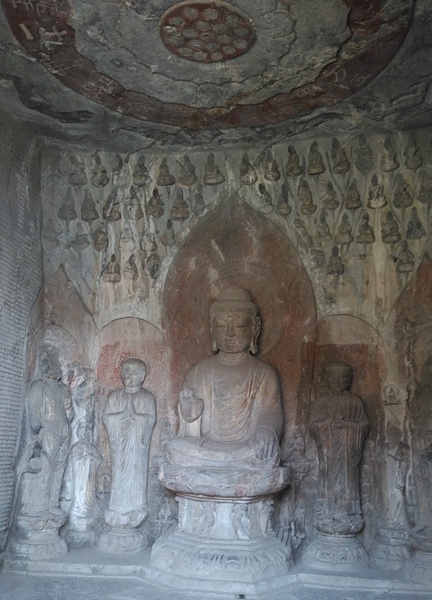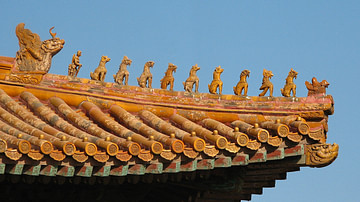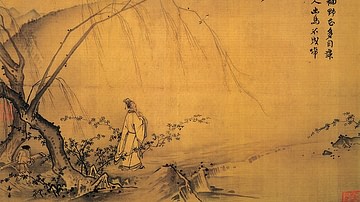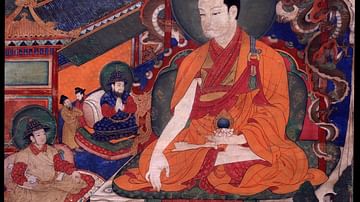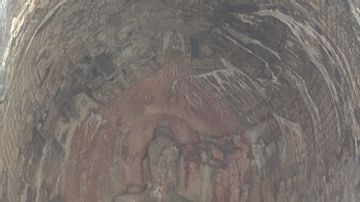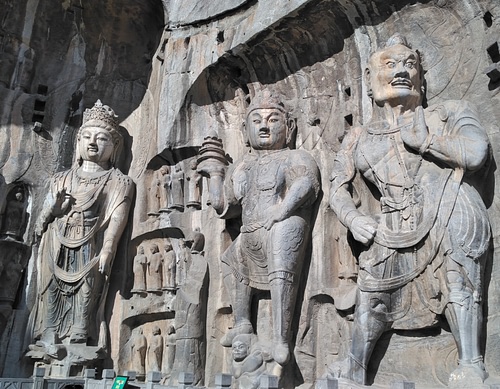
The Longmen Grottoes, a Buddhist cave complex located 13 kilometers south of Luoyang in China's Henan province, form some of the most significant and exquisite representations of ancient Chinese stone art. Created over the course of approximately five centuries beginning in 493 CE, these grottoes, along with the statues and inscriptions carved within, provide a window into the political, cultural, and artistic circumstances of the late Northern Wei and Tang periods. The caves were carved into the steep limestone cliffs of Mount Longmen and Mount Xiang which face one another along a one kilometer stretch, forming a valley through which the Yi River flows. This site, with its appearance of a natural gate, was historically referred to as Yique or "Gate of the Yi River." After Emperor Yang of the Sui Dynasty built an imperial palace in Luoyang at the beginning of the 7th century CE with its southern gate aligned to the cliffs of the site, the name Longmen or "Dragon's Gate" came into use (the dragon served as an emblem of the power of the emperor).
LAYOUT
In total, more than 2,300 grottoes and niches, 100,000 Buddhist statues, ranging in size from several centimeters to over 17 meters, and over 2,800 inscriptions were carved into the cliffs at the site, making it the largest such complex in China. A majority of the caves were carved into the face of Mount Longmen, on the west side of the Yi River. Such is the density of grottoes and niches there that they give the cliff face an incredible, honeycomb-like appearance when viewed at a distance. Whereas those grottoes on the west side were used for ceremonies which honored the dead, the caves carved on Mount Xiang to the east were home to a large community of Buddhist monks of various sects.
REFLECTION OF SOCIETY
The carving of grottoes into remote mountainsides to serve as Buddhist temples was a practice which originated in India c. 3rd century BCE. Buddhism, along with the practice of grotto carving, passed to China along the silk road, influencing the creation of Buddhist grottoes at Yungang near Pingcheng (modern day Datong), the capital of the Northern Wei Dynasty, in the middle of the 5th century CE. When Emperor Xiaowen, who contributed to the carving of the Yungang Grottoes, moved the capital from Pingcheng to Luoyang in 493 CE, he shifted his energy to beginning grotto construction at Longmen.
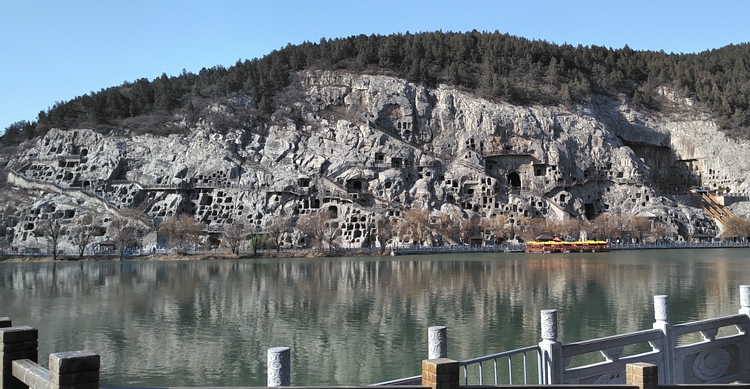
Many of the statues within the oldest grotto carved there, Guyang Cave, were ones which members of the royalty, who followed Emperor Xiaowen to Luoyang, vowed to build. Over 1,000 niches and 800 inscriptions are contained within the cave, making it one of the richest at Longmen and significant as a reflection of the late Northern Wei style of both sculpting and writing. The central statues of Sakyamuni Buddha and two Bodhisattvas (those on the path to enlightenment) each take on a somber appearance and a slender silhouette, contrasting the earlier, broad-shouldered style found at Yungang. Inscriptions attached to statues within Guyang Cave include 19 of the 20 inscriptions designated as exemplary forms of Northern Wei calligraphy and are critical in helping to identify the origins of each work.
After the fall of the Northern Wei Dynasty (535 CE), grotto carving slowed until the formation of the Tang Dynasty (618 CE) – the beginning of a stable and prosperous period marked by significant cultural achievements. During this time, the ascetic style of the Northern Wei gave way to a realistic, dramatic, and intricate style in which some 60% of all grottoes at Longmen were formed. The largest and most magnificent of these is unquestionably Fengxiansi Cave. Carved into the center of the rear wall of the cave is a colossal statue of Vairocana Buddha which, given the quiet elegance and slight smile of the figure, has been referred to as the "Mona Lisa of the East." The Vairocana statue is flanked by a set of disciples and Bodhisattvas, and by a set of heavenly kings and guardians carved into the side walls, forming a semicircle. Given that each statue has a markedly different and yet equally expressive personality, standing at the center of the group, facing the Buddha, is a truly awe-inspiring experience. Completed in 675 CE, the grotto was donated by Emperor Gaozong and Empress Wu Zetian (the first empress regnant in China) to honor their ancestors.
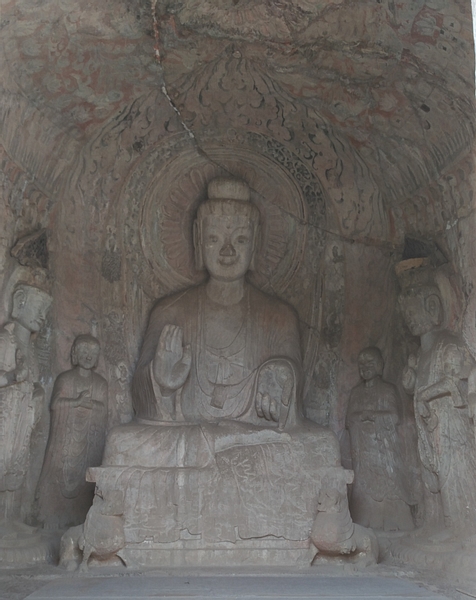
By providing those with sufficient financial resources the ability to dedicate a Buddhist image in order to transfer merit to a named beneficiary, often an emperor or one's parents, statuary art at Longmen ultimately served a spiritual purpose. Patrons of these figures represented a broad cross-section of society – royalty, court officials, military generals, monks, nuns, artisans, laypeople – many of whom included with their donation an inscription describing their motivation for and means of making the commission. By selecting the subject and style of the image, and by conveying their story through the inclusion of an inscription, ancient donors left behind a vivid portrayal of society in the region over a millennium ago.
NOTABLE CAVES
In addition to Guyang and Fengxiansi Caves, several others are particularly worthy of mention. The set of three Binyang Caves (North, Middle, South), carved shortly after the Northern Wei capital was moved to Luoyang, was donated by Emperor Xuanwu in honor of his father, Emperor Xiaowen, and mother, Empress Wenzhao. Unlike figures in Guyang Cave, those in the Binyang Caves are of an earlier Northern Wei style, closer to that found at Yungang Grottoes. Work began on Yaofang Cave in the intervening period between the Northern Wei and Tang dynasties and came to include the engraving of 140 Tang era medical prescriptions – practical remedies to ailments ranging from cholera to hysteria. These treatments, which spread to Japan in the 10th century CE, reveal the degree to which medical science advanced during the Tang Dynasty.
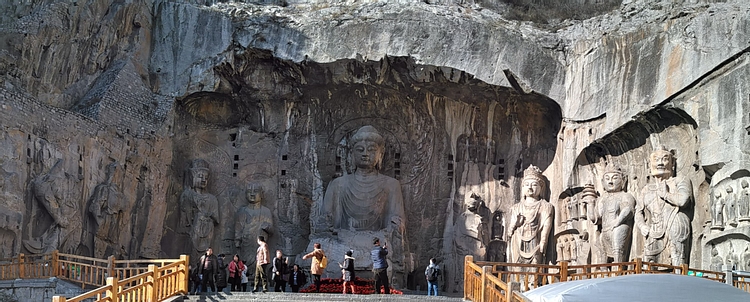
Wanfo Cave, which was completed shortly after the completion of Fengxiansi Cave, was created in honor of Emperor Gaozong and Empress Wu Zetian and purportedly contains 15,000 small, sitting Buddha figures carved within the vast grids of tiny niches which blanket several walls. Prominent patrons of the cave included a female court official and a palace chapel nun. The largest grotto on the east side, Kanjingsi Cave, unlike many other large caves, lacks the grouping of large, carved Buddhist statues. In their place is a procession of life-sized Arhats (those far advanced along the path to enlightenment) stretching around the perimeter of the cave, each with a unique expression, carved in relief in the evocative and highly-detailed style found at other Tang era grottoes.
PRESERVATION
One can only imagine the splendor of the grottoes at Longmen during the Tang Dynasty, with thousands of recently completed carvings painted in a brilliant array of colors. Unfortunately, a number of natural and human forces have detracted from, although in many cases by no means destroyed, the intention of the original artists. Among the natural causes of damage are corrosion due to acid rain, wear from wind exposure, and naturally occurring fissures of the limestone, exacerbated by plant growth and water seepage.
Although there is evidence that vandalization of the statues had already begun to occur by the 13th century CE, wide-scale looting took place during the early 20th century CE. Looters passed heads and hands of larger figures, or entire smaller figures, to art dealers in Beijing and Xi'an who in turn sold them to foreign art collectors and museums. Restoration of the site did not begin until the establishment of the People's Republic of China, an event which led eventually to refurbishment work on Fengxiansi Cave in 1971 CE. To protect against collapse and water damage, statues were reinforced, original drainage channels were restored, roofs were created above grottoes, and waterproofing was added to statues. In 2000 CE the site was inscribed on the UNESCO World Heritage List.
As with pilgrims of ages past, who visited Longmen to worship or to gain merit through the dedication of a Buddhist image, these grottoes afford modern visitors the chance to take a step closer to the lives of people from a different era, and to stand in wonder at the ability and determination of humankind.

